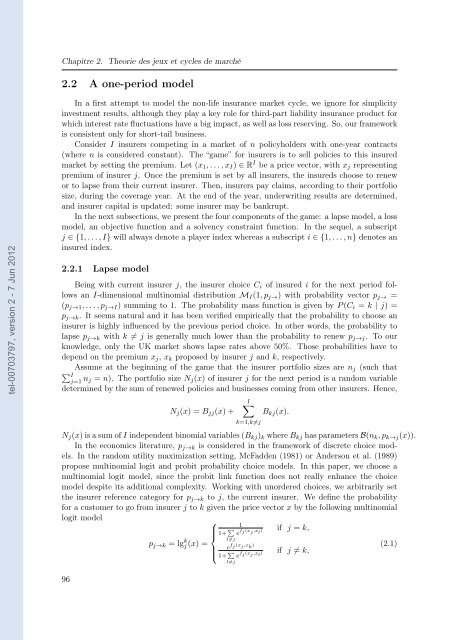Etude des marchés d'assurance non-vie à l'aide d'équilibres de ...
Etude des marchés d'assurance non-vie à l'aide d'équilibres de ...
Etude des marchés d'assurance non-vie à l'aide d'équilibres de ...
You also want an ePaper? Increase the reach of your titles
YUMPU automatically turns print PDFs into web optimized ePapers that Google loves.
tel-00703797, version 2 - 7 Jun 2012<br />
Chapitre 2. Theorie <strong><strong>de</strong>s</strong> jeux et cycles <strong>de</strong> marché<br />
2.2 A one-period mo<strong>de</strong>l<br />
In a first attempt to mo<strong>de</strong>l the <strong>non</strong>-life insurance market cycle, we ignore for simplicity<br />
investment results, although they play a key role for third-part liability insurance product for<br />
which interest rate fluctuations have a big impact, as well as loss reserving. So, our framework<br />
is consistent only for short-tail business.<br />
Consi<strong>de</strong>r I insurers competing in a market of n policyhol<strong>de</strong>rs with one-year contracts<br />
(where n is consi<strong>de</strong>red constant). The “game” for insurers is to sell policies to this insured<br />
market by setting the premium. Let (x1, . . . , xI) ∈ R I be a price vector, with xj representing<br />
premium of insurer j. Once the premium is set by all insurers, the insureds choose to renew<br />
or to lapse from their current insurer. Then, insurers pay claims, according to their portfolio<br />
size, during the coverage year. At the end of the year, un<strong>de</strong>rwriting results are <strong>de</strong>termined,<br />
and insurer capital is updated: some insurer may be bankrupt.<br />
In the next subsections, we present the four components of the game: a lapse mo<strong>de</strong>l, a loss<br />
mo<strong>de</strong>l, an objective function and a solvency constraint function. In the sequel, a subscript<br />
j ∈ {1, . . . , I} will always <strong>de</strong>note a player in<strong>de</strong>x whereas a subscript i ∈ {1, . . . , n} <strong>de</strong>notes an<br />
insured in<strong>de</strong>x.<br />
2.2.1 Lapse mo<strong>de</strong>l<br />
Being with current insurer j, the insurer choice Ci of insured i for the next period follows<br />
an I-dimensional multinomial distribution MI(1, pj→) with probability vector pj→ =<br />
(pj→1, . . . , pj→I) summing to 1. The probability mass function is given by P (Ci = k | j) =<br />
pj→k. It seems natural and it has been verified empirically that the probability to choose an<br />
insurer is highly influenced by the previous period choice. In other words, the probability to<br />
lapse pj→k with k = j is generally much lower than the probability to renew pj→j. To our<br />
knowledge, only the UK market shows lapse rates above 50%. Those probabilities have to<br />
<strong>de</strong>pend on the premium xj, xk proposed by insurer j and k, respectively.<br />
Assume at the beginning of the game that the insurer portfolio sizes are nj (such that<br />
I<br />
j=1 nj = n). The portfolio size Nj(x) of insurer j for the next period is a random variable<br />
<strong>de</strong>termined by the sum of renewed policies and businesses coming from other insurers. Hence,<br />
Nj(x) = Bjj(x) +<br />
I<br />
k=1,k=j<br />
Bkj(x).<br />
Nj(x) is a sum of I in<strong>de</strong>pen<strong>de</strong>nt binomial variables (Bkj)k where Bkj has parameters B(nk, pk→j(x)).<br />
In the economics literature, pj→k is consi<strong>de</strong>red in the framework of discrete choice mo<strong>de</strong>ls.<br />
In the random utility maximization setting, McFad<strong>de</strong>n (1981) or An<strong>de</strong>rson et al. (1989)<br />
propose multinomial logit and probit probability choice mo<strong>de</strong>ls. In this paper, we choose a<br />
multinomial logit mo<strong>de</strong>l, since the probit link function does not really enhance the choice<br />
mo<strong>de</strong>l <strong><strong>de</strong>s</strong>pite its additional complexity. Working with unor<strong>de</strong>red choices, we arbitrarily set<br />
the insurer reference category for pj→k to j, the current insurer. We <strong>de</strong>fine the probability<br />
for a customer to go from insurer j to k given the price vector x by the following multinomial<br />
logit mo<strong>de</strong>l<br />
pj→k = lg k ⎧ 1<br />
⎪⎨ 1+<br />
j (x) =<br />
⎪⎩<br />
<br />
e<br />
l=j<br />
fj (xj ,xl ) if j = k,<br />
e fj (xj ,xk )<br />
(2.1)<br />
if j = k,<br />
96<br />
1+ <br />
e<br />
l=j<br />
fj (xj ,xl )
















